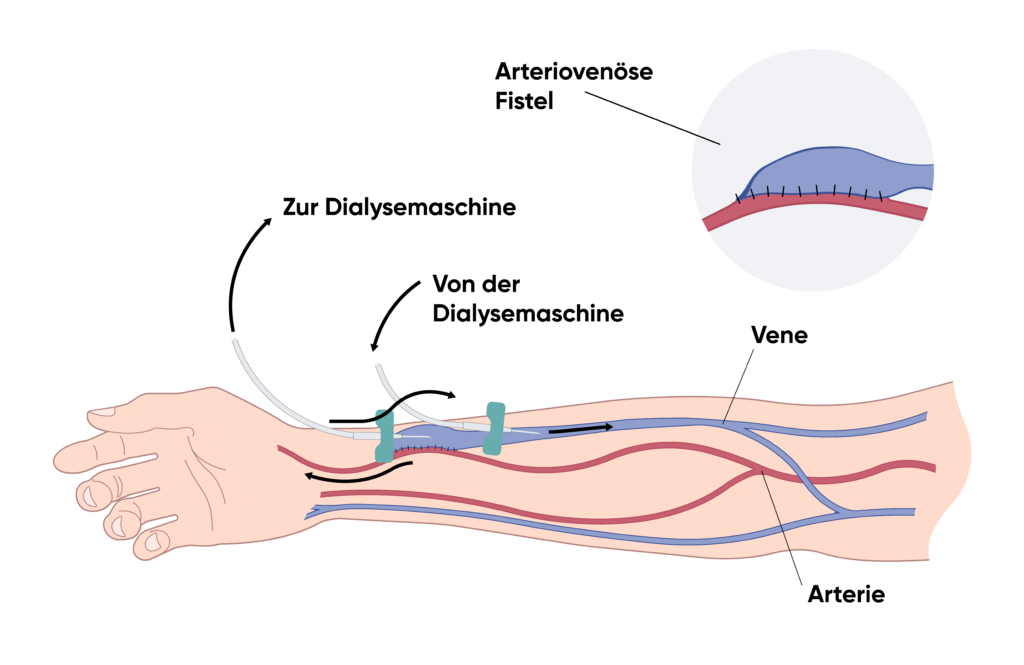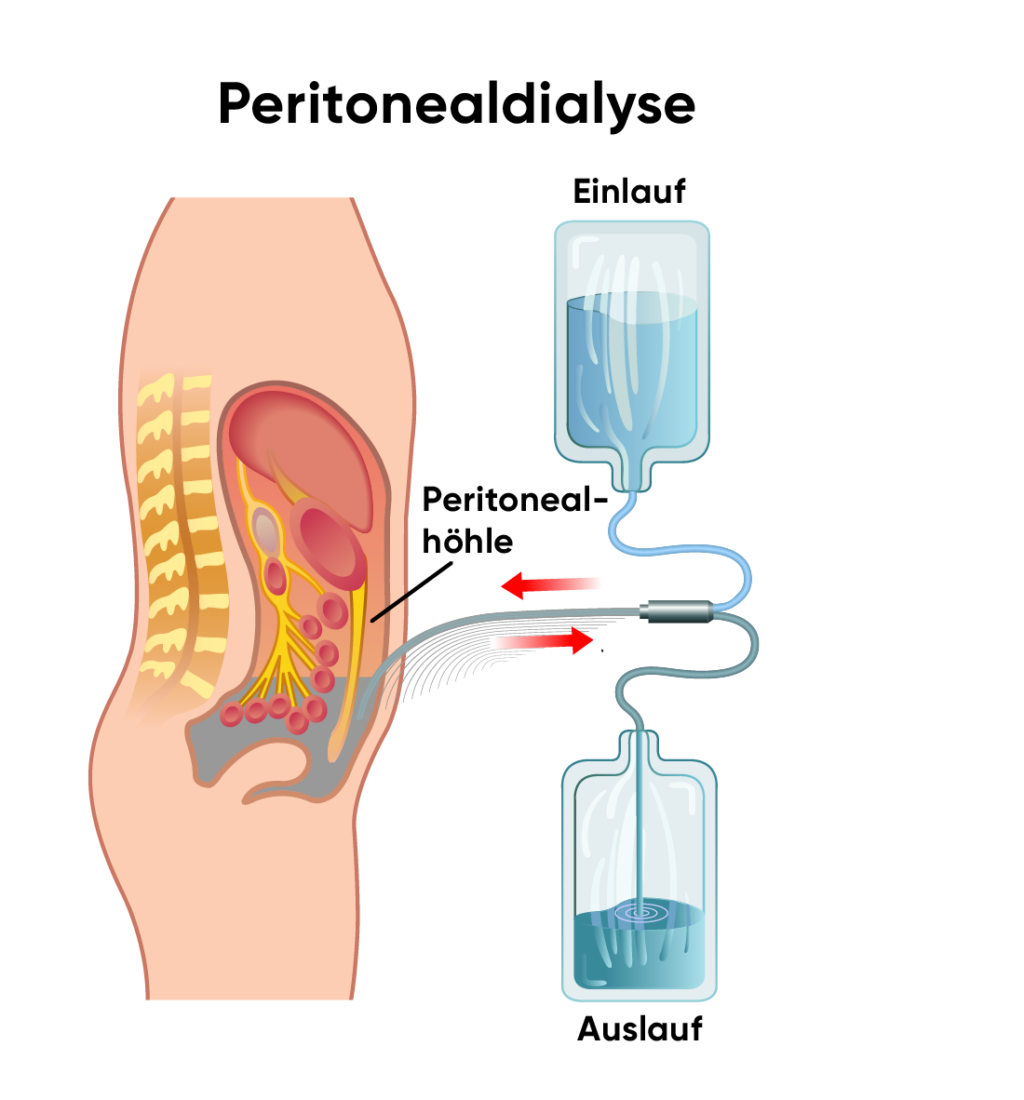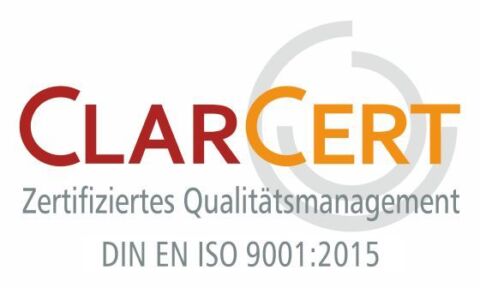Overview: What are the common dialysis procedures?
Blood washing outside the body
There are various methods of dialysis, the most common form being hemodialysis. In this procedure, the patient’s blood is passed through a filter outside the body and “washed”. The patient is connected to a dialysis machine several times a week for a few hours. During this time, the blood circulates several times through the dialysis filter, the so-called artificial kidney, where it is purified and fluid can also be removed. Hemodialysis is carried out in special dialysis centers where specialist staff care for and monitor the patients, but can also be carried out by the patients themselves at home as so-called home dialysis.

Peritoneal dialysis
In peritoneal dialysis, the cleansing process takes place via the peritoneum. Several times a day, a sterile dialysis fluid is introduced into the abdominal cavity, where it saturates with waste products and is then exchanged. Peritoneal dialysis also offers the possibility of removing additional fluid. After appropriate training, the patient can perform peritoneal dialysis at home.

Highly specialized dialysis treatment at the University Hospital Zurich
Before deciding which dialysis procedure is most suitable for you, it is essential that you inform yourself well, ideally together with your family. There are many different options for an optimal dialysis procedure. The decision not only concerns whether and which dialysis procedure is best suited, but also what the future looks like: is a transplant an option for me, what does dialysis treatment mean for my family, can I go on vacation, what does my independence look like, what happens if I don’t want to do dialysis, where can I have dialysis?
There are a lot of questions and we are happy to help you with our nephrology team of nurses and doctors. We also offer discussions with the nutritional counseling team, the transplant team and, if necessary, other specialists at the University Hospital Zurich (USZ). The decision also depends heavily on the form of your illness and your individual circumstances. The Nephrology Clinic at the USZ offers separate consultation hours for each type of dialysis. To register, you need a referral from your family doctor or a specialist.
We have many years of experience with the various dialysis procedures that have to be carried out in inpatient or intensive care settings for patients who are sometimes very seriously ill. Here we can also carry out more specialized dialysis procedures, such as immunoadsorption for immune disorders. At the same time, we also look after patients who come for dialysis on an outpatient basis and just last year we set up a new dialysis unit at the airport in the Circle with 16 additional places. This dialysis unit is very conveniently located in an attractive area with cafés, department stores, restaurants and in the immediate vicinity of the airport.
Thanks to our inpatient and outpatient treatment options and our broad expertise and number of beds, we are able to offer a wide range of dialysis options and an additional evening shift for working people. We carry out around 10,000 dialysis treatments every year.
Dialysis center at USZ Airport
The University Hospital Zurich offers a dialysis center with 16 treatment places in the USZ Airport Outpatient Clinic. We are happy to look after you in a pleasant atmosphere at university level.
Hemodialysis
In hemodialysis, the blood is passed through a filter, the so-called artificial kidney. In order for this blood flow to be sufficiently large, a suitable access is needed to drain the blood. The superficial small veins are not suitable for this, so a small operation, sometimes under local anesthesia, is performed to create a separate connection between an artery (supplying vessel) and a vein (disposing vessel).
Dialysis access for sufficient blood flow
This “short circuit”(dialysis shunt) between the blood vessels causes more blood to flow directly from the artery into the vein, which expands over time. This is why there are always a few weeks between the operation and the start of dialysis. The dialysis shunt makes it easier to insert the 2 cannulas required for blood washing, i.e. one for the outflow and one for the return flow. The blood is then purified outside the body in the dialysis filter and returned to the patient. If it is not possible to create a vascular access, it is also possible to create a permanent small tube access in a larger blood vessel (usually under the collarbone). Dialysis treatment can then be carried out via this dialysis catheter, the so-called Permcath.
A dialysis session lasts four to five hours
The actual blood purification takes place via the artificial kidney, i.e. the dialysis filter or dialyzer. The blood is pumped through this filter and then flows back into the body in a purified state. Metabolic breakdown products are filtered out in the dialysis filter and fluid is also removed. Dialysis usually lasts between four and five hours and takes place three times a week. This provides an artificial kidney replacement for approx. 12-15 hours per week, i.e. the hemodialysis treatment only replaces approx. 15% of the kidney output of a healthy person.
Other important aspects of dialysis treatment
In addition to the pure removal of metabolic products, the removal of fluid is also important, as this is often no longer carried out sufficiently by the kidneys. It is important that the circulation is stable during treatment and that blood pressure is constantly monitored. As a rule, heparin is also administered during hemodialysis to prevent the blood from clotting. In addition, some minerals, iron and vitamins must also be replaced.
Peritoneal dialysis
In peritoneal dialysis, the blood is not cleansed outside the body, but is washed inside the abdominal cavity.
Blood washing in the abdominal cavity via a catheter
In peritoneal dialysis, doctors insert a catheter into the patient’s abdomen. This is done as part of a minor operation about 14 days before the start of dialysis. Here too, we work as a team with our colleagues from visceral and transplant surgery.
Über diesen Bauchkatheter wird mehrmals täglich Dialyseflüssigkeit in den Bauchraum geführt. In this form of blood washing, the peritoneum acts as a filter membrane, so to speak, and channels the waste products into the dialysis fluid. The fluid is drained after a certain period of time and the abdominal cavity is refilled with fresh fluid. This procedure is repeated several times a day, e.g. 3-4 times, with the fluid remaining in the abdominal cavity for approx. 3-4 hours each time. Alternatively, this treatment can also be carried out during the night. Here it is possible to have an automatic machine perform the inflow and outflow so that peritoneal dialysis can be carried out while the patient is asleep.
Peritoneal dialysis as a treatment option
Peritoneal dialysis is usually carried out by the patient at home after a short training phase. Peritoneal dialysis requires personal responsibility and hygiene, but also allows more self-determination and freedom. Unfortunately, it is not suitable for everyone with kidney disease. Let the Department of Nephrology at the USZ advise you in detail about which procedure is best for you. We are also happy to organize discussions with other patients who can report on their experiences.
Kidney transplant
Dialysis treatment is the rule when a patient needs a kidney replacement procedure quickly. Around 50,000 people in Switzerland live with declining kidney function, and around 4,500 to 5,000 patients have to undergo dialysis on a regular basis. But it is important to know that the possibility of a kidney transplant must always be considered. Dialysis does not rule out a transplant. It should always be clarified whether a kidney transplant is possible. There are very few exclusion criteria and we at the USZ, as the largest kidney and organ transplant center in Switzerland, always check what the best options are for the individual patient. The possibility of a living kidney donation must also always be considered, and we can also help with this during the consultation. We are very, very cautious about giving consent for a living kidney donation, but if the thorough examinations and clarifications show that the risk for the donor is as low as possible, we support this option. Between 80 and 100 kidneys are transplanted at the USZ every year, around a third of which come from living donors. If you do not have a living donor and are put on the waiting list for a kidney from a deceased donor, the average waiting time is around 3 years. We hope that this waiting time will also be significantly reduced in the future as a result of the approval of the extended objection solution.
Especially in cases of uncertainty and questions, e.g. am I too old for a transplant or for a donation, do I have a different blood group than my partner, do I also have a heart disease or diabetes, a consultation with the specialists at the USZ is very necessary. In the special consultation hours, we have time to discuss questions about kidney transplantation with you and your family.
University Hospital Zurich – the future has already begun
Medical progress offers hope. We are actively involved in setting up the national crossover living donation program. This makes it possible to find the best recipient-donor combinations for a kidney transplant, even for couples who previously had no chance. So far we have successfully transplanted 4 such pairs.
Our tolerance program is even more innovative. At the USZ, we are the first clinic in Europe to have transplanted patients who have received not only the kidney but also parts of the immune system in the form of bone marrow stem cells from the donor. In the best-case scenario, these patients can do without the otherwise necessary immunosuppressive medication that prevents rejection of the foreign organ in the long term. Some of them have already succeeded!


